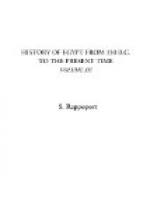A detailed and elaborate examination of the relative positions of the tombs, their dimensions, and the objects found in them, compared with the various fragments of historical records of the early dynasties, enables us to reconstruct the exact order of these ancient rulers. This sequence is:
[Illustration: 362.jpg TABLE OF ANCIENT RULERS]*
* Ka and Zeser were possibly brothers of Mena.
Following the dating tentatively computed by Professor Petrie, the dates of some of these kings are:
[Illustration: 363a.jpg TABLE OF CHRONOLOGY OF EARLY KINGS]
Thus we have reconstructed the list of Thinite kings before Mena so far as the facts allow, and perhaps so far as we are ever likely to ascertain them.
The facts about the second dynasty, the kings after Qa, must now be studied. In the tomb of Perabsen it was found that there were buried with him vases of three other kings, which are therefore his predecessors. Their names are Hotepahaui, Raneb, and Neteren; and it is certain that Raneb preceded Neteren, as the latter had defaced and re-used a vase of the former. As on statue No. 1, Cairo Museum, these three names are in the above order, and, as the succession of two of them is now proved, it is only reasonable to accept them in this order. From all the available facts it seems that we ought to restore the dynasty thus:
[Illustration: 363b.jpg TABLE OF KINGS]
The oldest tomb that we can definitely assign is that marked B 7, the tomb of King Ka. This is a pit with sloping sides; the thickness of the brick walls is that of the length of one brick, and the soft footing of the wall and pressure of sand behind it has overthrown the longer sides.
[Illustration: 364.jpg ENLARGED PLAN OF FIRST DYNASTY TOMBS]
The broken pottery mixed with the sand, which filled it, largely consisted of cylinder jars, like the later prehistoric form; and these had many inscriptions on them, written in ink with a brush, most of which showed the name of Ka in the usual panelled frame. There can therefore be no doubt of the attribution of this tomb.
The tomb B 9 is perhaps that of King Zeser, who seems to have been a successor of Ka. It is of the same construction as that of Ka. The tomb B 10 appears to be the oldest of the great tombs, by its easternmost position; and the objects of Narmer point to this as his tomb. In both the thickness and the batter of the walls there is a care shown in proportioning the strength of the ends and the sides. The tomb B 15 is probably that of King Sma. Its walls are not quite so thick, being fifty inches at the end. The post-holes in the floor suggest that there were five on the long side, and one in the middle of each end, as in the tomb of Narmer. But along the sides are holes for roofing beams near the top of the wall. These roof beams do not at all accord with the posts; and this proves that, here at least,




